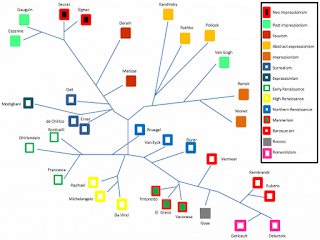A blog dedicated to recent developments in psychophysiology and clinical applications of ERP in neuropsychiatry. Ghent University Institute for Systems learning and Applied Neurophysiology.
05 oktober 2012
ART SMART
Making broad differentiations between modern and classic paintings can be fairly easy for the untrained eye, but telling the difference between an Impressionist and a Post-Impressionist painting may require a certain knowledge of art history. Well, it ain’t necessarily so when it comes to computers. An algorithm created and tested by computer scientists Lior Shamir and Jane Tarakhovsky, of Lawrence Technological University in Michigan has produced surprisingly accurate and expert results in art analysis.
The experiment was performed on approximately 1,000 paintings by celebrated artists. The technique is based on numerical image context descriptors, 4,027 of which were computed from each painting. These are numbers that identify the content of the image such as texture, color and shapes. Pattern recognition and statistical methods then analyze various aspects of the visual content of the paintings in order to detect patterns of similarities and dissimilarities between different painting styles. The feat is achieved without any human assistance in the process – or a degree in art history.
The algorithm succeeded in producing a network of similarities between painters that was largely consistent with the analysis that an art history expert would make. For example, the computer clearly identified the differences between classical realism and modernism. But it went further. Inside each of these two groups, it identified sub-groups that were part of the same movement. For example, it deduced that Gauguin and Cézanne should be clustered together, which is correct, since they are both Post-Impressionist painters. It also lumped together Raphael, Leonardo da Vinci and Michelangelo as representatives of the High Renaissance period
Abonneren op:
Reacties posten (Atom)

Geen opmerkingen:
Een reactie posten